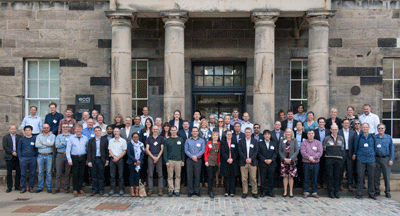The 11th meeting of the IEAGHG's Monitoring Network and the 6th meeting of the Modelling Network took place in Edinburgh last week, as a combined meeting, hosted by BGS and SCCS.
These meetings bring together leading experts from research and industry to discuss the latest work and developments, with around 60 participants from 11 countries at this one.
The overall theme for this meeting was 'using the modelling-monitoring loop to demonstrate storage performance more effectively'. Sessions included on monitoring induced seismicity, novel monitoring techniques, monitoring costs, near-surface natural variability, monitoring CO2-EOR, wellbore integrity issues, modelling environmental conditions, updates from ongoing and closed projects, lessons from other industries, modelling reservoirs and overburden, pressure measurements, and conformance in the monitoring modelling loop.
Key findings from advances in monitoring included the benefits, and some limitations, of the use of fibre-optic distributed acoustic sensors (DAS) from experiences in being deployed at projects, including helical configured cables to overcome the directional limitations. A topic of much discussion at previous meetings has been how to reduce the level (and cost) of monitoring for commercial-scale projects compared with the initial research-orientated projects. At this meeting we saw how this is now happening at Shell's QUEST project in Alberta where they are able to streamline their initial MMV strategy without losing monitoring effectiveness, including the use of a new laser-based low-cost leakage detection technique over the well area. We also saw this principle go further with the MRV plan for Occidental's CO2-EOR project.
In terms of leakage detection, much discussion centred around the temporal and spatial complexity of near-surface baselines and the implications for near-surface monitoring - its purpose, optimization and value to stakeholders, and hence the need for attribution methodologies to identify genuine leakage, with an example from Japan on a new ratio-based technique for doing this for offshore leakage and the suggestion that onshore, ratios representing biologic respiration could be broadly defined as the threshold for defining leakage.
In terms of modelling, the complexities and challenges of upscaling from pore to core to reservoir were discussed, highlighting the importance of the influence of heterogeneity in the reservoir. Modelling flow in wellbores was discussed with several examples showing that it can require a different modelling approach. The US DOE's NRAP programme has produced 10 'tools' for reduced-order modelling of different aspects of CO2 storage, these are being beta-tested at the moment and useful feedback was given in a dedicated session.
In terms of wellbore integrity, recent hydrocarbon exploration and storage leakage events are being assessed for any lessons that could be relevant for CO2 injection control, including modelling the complex interactions between wellbore and formations. Examples included a very interesting analysis of the recent Aliso Canyon natural gas leak in California.
More knowledge is being developed around migration and leakage in the overburden, and the CaMI controlled release site will be very useful. A detailed MMV plan, with international collaborators, has been devised for the site ahead of planned injection for later this year.
Based upon the presentations and detailed discussion, recommendations for further work were made, including on the testing of techniques and experience of CO2 well control, and on modelling of wellbore and near-wellbore events. Proposals were also made for more case studies on what conformance looks like in practice, and more work on models of dissolution processes.
Overall conclusions were that good progress is being made with learning from the demonstration and pilot projects in both monitoring and modelling which is then able to be shared with the international community at these meetings, and that there is progress in streamlining MMV at projects and reducing the costs of monitoring. We now have several sites demonstrating conformance of the modelling-monitoring loop, so that the understanding of conformance is becoming more mature.
BGS also organised a very interesting field trip that benefited from the diverse geology of the area, including the classic site of Hutton's unconformity at Siccar Point.
Overall, an exciting meeting of many new developments, the main challenge being sufficient time for all the interesting discussions. A big thank you to Sarah Hannis and her colleagues at BGS, along with SCCS, for hosting the meeting. Many thanks to the main sponsor, UKCCSRC. Presentations will be available on the IEAGHG Networks' webpages and a full report will be produced.
